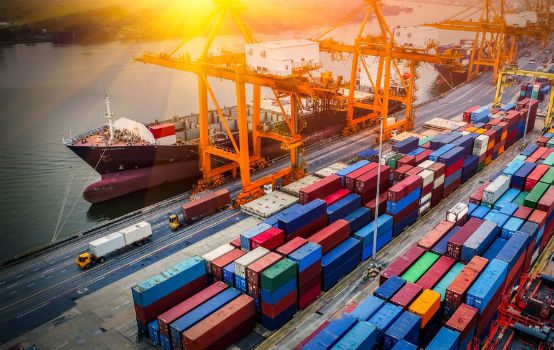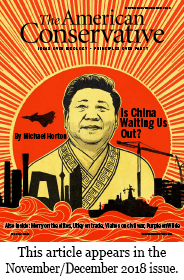A Moment of Praise for Open Trade

With President Donald Trump’s aggressive new trade policy—replete with tariffs, threats, and breaking up international trade deals—it is again in vogue to attack free trade. In fact, there’s an impulse to blame all economic ills on it today. But these broadsides are based on misinformation, misunderstandings, or concepts based on century-old history. Basing our reactions on wrong information or interpretation will lead us to wrong-headed policies.
Even in these pages there are disagreements among conservative writers and analysts, some of whom are quick to blame the decline of industrial America, particularly economic decline in the heartland, on China and U.S. companies moving abroad for cheaper labor and lower taxes. This article takes on nine points of contention.
The interests of consumers are usually ignored in debates about jobs. All ofTrump’s talk about trade revolves around jobs. Well, what about consumers? Yes, many manufacturing jobs have disappeared but hundreds of millions of Americans benefit from lower cost and better quality goods today. Remember how often U.S.-made cars used to break down? Now they last 100,000 miles with barely a repair. Low-income families benefit from the affordable Walmart-like prices and pay less for most necessities, relative to their incomes, than ever before.
Millions of blue collar jobs were not lost to China. This has been claimed by some of our own TAC writers but it’s not entirely true. Rather it was automation, computers, and new software to run them that took the place of workers. In a 2016 piece, “Don’t Blame China For Lost Jobs,” Fortune magazine cites a detailed study that “trade accounted for 13% of the lost U.S. factory jobs, but 88% of the jobs were taken by robots and other factors at home.” In a 2016 report, Forbes magazine explains further: “The truth is that America lost some 7 million manufacturing jobs and added some 53 million jobs in services. This is just what happens with advanced economies—it’s easier to increase productivity in manufacturing than it is in services.” Of those new jobs, the article says, 62 percent paid more. “Yes, really, 33 million higher paying service jobs came along to replace those 7 million lost.”
In addition, a long, detailed study by the St. Louis Federal Reserve, “Is U.S. Manufacturing Really Declining?” shows that manufacturing’s share of real gross domestic product has been consistently around 12 percent since the year 2000. The misconception that we are losing our manufacturing industries arises from the abundance of foreign-made simple consumer goods; most shoppers don’t see America’s high-tech and heavy industry exports, which are truly competitive worldwide.
American industries are very competitive in new and advancing fields. These include modern engineering, production technology, chemicals, oil drilling, software, 3D printing, movies, music, computers, electronics, video gaming, and a host of specialized small industries. For example, Michigan, a Rust Belt state, has created hundreds of thousands of new jobs in the last nine years, including more than 700,000 in what’s called “advanced manufacturing,” meaning the use of innovative technology to improve products or processes. These are much better jobs than the lost ones in making simple goods.
It is in many of these millions of new jobs that America leads the world. For example, Apple alone directly employs some 80,000 people in the U.S. and indirectly tens of thousands more. Farming used to be the mainstay work of nearly all Americans; it now employs just 1 or 2 percent of our population. Assembly line manufacturing requires less and less labor; most job growth in advanced economies is in service industries.
Protectionism usually protects existing, old industries with political power. Witness Trump’s 25 percent steel tariffs: companies that rely on steel inputs, which employ dozens of times more workers, have seen their raw material costs rise some 50 percent from $600 to $900 per ton for flat rolled steel, the most commonly used, according to reporting from The Wall Street Journal. Ford Motor Company, for example, recently announced a $1 billion decline in earnings because of these tariffs and has now announced worker layoffs.
Service jobs must be included in trade statistics. Trump’s programs and his understanding of trade only address manufacturing jobs. In service jobs America has a yearly positive trade balance of $244 billion, which Trump ignores when he repeatedly claims we have an $800 billion negative balance in goods. He constantly accused Canada of taking advantage of the U.S. through its positive trade surplus. But according to the Office of the United States Trade Representative, the U.S. enjoyed a $12.5 billion trade surplus with Canada in 2016. A $12.1 billion U.S. deficit in goods was overcome by a $24.6 billion surplus in services, according to New York Times reporting. Service jobs—including repairs, law and accounting, healthcare, sales, tourism, banking, insurance, education, travel, computer and Internet functions, and more—account for some 90 percent of private sector jobs in America today.
Invoking 19th century American trade policies as a positive example for protectionism today is preposterous. At that time railroads brought about the creation of a vast domestic marketplace, and technological advancements brought about steam engines and the beginnings of mass production. Today, when people and goods can travel in hours between continents, it means jets, computer chips, billion dollar assembly lines all of which require a worldwide market to be profitable.
American trade helped bring about American hegemony over the rest of the world, yes. But it also fostered tremendous good will and the spread of American concepts of rule of law and limited government. To throw this all away with the idea of turning America into a quasi-colonial enterprise aimed at squeezing the most money from our trading partners can only hurt us. When we tested trade protectionism in the 20th century with the Smoot-Hawley tariffs it extended and deepened the Great Depression. The brilliant supply-side economist Jude Wanniski was first noted for his studies showing that the 1929 crash occurred the day after the coalition to block Smoot-Hawley fell apart in Congress.
Corporations set up in other countries because labor is cheaper. The cost of American labor has always been much higher than that of developing nations. But Germany has higher labor costs than America’s, and still has a positive trade balance. Our labor can well compete, but our labor-intensive industries are incredibly burdened by wasteful regulations and our dysfunctional, incredibly expensive healthcare system. Companies forced to pay over $14,000 per employee for health insurance face a tremendous extra cost burden. Our healthcare costs as a percentage of our gross national product are almost double compared to the Europeans. It is often argued that blue collar wages in America have been stagnant for years. That’s not true; rather, potential pay increases have instead been siphoned off by the extraordinary cost of healthcare.
Furthermore, there are millions of jobs going unfilled. Just search the Internet for unfilled jobs. Tracking nearly all students for college is a gigantic waste; many could instead earn very good salaries by developing blue collar skills. Many rapidly reach salaries of $50,000, more than is earned by vast numbers of college graduates.
Immigrants do not “take away” American jobs. We need temporary unskilled immigrant labor to maximize job creation. Already, for example, our fishing industry is under strain because seasonal immigrant labor has been cut off. There are continued severe unskilled labor shortages in summer jobs for agriculture, construction, and home healthcare.
We should reform our immigration system to accept more migrants with high-tech skills. CNBC reported in March of this year that “half of the top American tech companies were founded by immigrants or the children of immigrants.” In my own reporting for TAC, “In Praise of Immigrants,” I wrote that immigrants don’t, in total, take jobs away from Americans—they create jobs for Americans. Interestingly, Canada is moving in an entirely opposite direction from Trump, processing visas for those with vital skills in two weeks and granting permanent resident visas for those people in six months.
Mexico and Canada weren’t the only ones benefiting from NAFTA. America benefits from a prosperous world and especially from having prosperous neighbors. Yet one of Trump’s most demanding proposals upon Canada and Mexico was doing away with the impartial settlement system for arbitrating disputes. He gave up on this in the last-minute final agreement with Canada. His trade czar Robert Lighthizer has argued that he wants American investment in Mexico to be less secure on the theory that Americans will then invest less in Mexican businesses. He also wants to break up global supply chain manufacturing, which ties our nations together and makes our industry more efficient and competitive. The final agreement will maintain these supply chains for the U.S., Mexico, and Canada, but curtail them for European and Chinese inputs.
So what if we could “win” a trade war? America helped billions of human beings escape from the starving misery of past centuries. We won against Soviet communism not because of our weapons, but rather because of our ideas and the examples we set.
Globalism is not hurting our American culture. Much of older conservatives’ opposition to trade is not really grounded in economics but in thinking that globalism through trade (and immigration) undermines American culture and values and dilutes our racial mix. Polling shows that most younger Americans have little concern for these issues. I wrote about this for TAC in an online article, “How to Resolve the Conservative Split on Immigration.” The reason Trump and the Republicans won the last election was not just because of perceived job losses from trade, but from job killing regulations and environmental policies and the Democrats’ obsession with social issues like transgenderism.
Most Americans still support free trade. In September, Brookings Institution fellow William Galston wrote in The Wall Street Journal that support for NAFTA increased from 42 percent to 63 percent during the last 10 years. Additionally, 80 percent of Americans believe that expanding exports is the best way to create jobs compared to 17 percent who did not.
The immediate consequences of Trump’s trade war will be a wave of price increases as most of the tariffs’ costs will be passed on to consumers, as noted above about steel costs. The Washington Post quotes a study that most of the Trump taxes so far have hit American companies producing in China for export to America. China mainly assembles high-tech goods with inputs from other countries. Most of the value of the Apple iPhone, for example, comes from key inputs from Japan, Korea, Germany, and the U.S.
CNBC’s finance commentator Jim Cramer notes that growth will slow among our largest corporations because it was mainly expected to come from their participation in China’s growing markets. Our farm sector will see declining incomes from exports. European companies may gradually replace American ones in China. Trade conflicts with our European allies will weaken their cooperation with other American foreign policy objectives; China and Russia have already started cooperating to offset American trade actions. New wars may result. Remember the old saying, “if goods don’t cross borders, then armies will.”
Jon Basil Utley is publisher of The American Conservative.

Comments